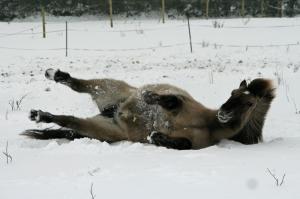Feeding Icelandics
Icelandics are generally very easy to feed. The main problem is not allowing them to become too fat. If you have good grass throughout the year they will probably not need any extra food unless you are working them hard. In the spring and summer, you may need to restrict your horses´ grazing time to stop him getting too fat. Provide a salt and mineral block with free access, and of course plenty of fresh water that won´t freeze in the winter.
If you have a “real” winter, then your Icelandic will need good hay or haylage. Silage is too rich, but good quality straw can be used as a “filler” for greedy horses. If you are working your horse hard, or using it for breeding, or it is very old, then it will probably need extra food. Avoid food which is too high in protein, and remember that even though Icelandics are tough, any food which they have must be of good quality.
How to tell if your horse is the correct weight
Weight tapes and weigh bridges are fine but there´s a quick and easy way to check your horse´s waistline. To know if your horse is fat or thin, you need to touch him. Unless he is grossly overweight and on the verge of laminitis, or half-starved, you cannot do it just by looking at him. Put your hand flat on his side, mid-way between his shoulder and his flank. With a little pressure you should be able to feel his ribs. If you need to press really hard or use just your fingertips, your horse is probably too fat. If you can easily feel every rib, he´s on the thin side. If you can see his ribs he´s definitely too thin.
This method isn´t totally infallable as a few Icelandics carry much of their fat on their necks, so check the crest is soft and wobbly just to make sure. If your horse is losing weight, the skin over his ribs will be very loose. If he´s gaining weight it will feel quite tight.
Should I clip my Icelandic?
If your horse is sweating up a great deal in the autumn and winter you may need to clip him. A wet sweaty horse should never be turned out if the weather is cold or wet; he should be kept in a stable until he is dry or he will be at risk from cold and chills. A clipped horse does not sweat as much and dries much quicker. A bib clip (clipping the hair on the underside of the neck and on the chest) will keep your horse cooler when working but he will still have enough fuzz to keep him warm in bad weather. A more radical clip (a trace or full clip) will mean that you may have to put a rug on your horse in cold, wet or windy weather.
Sweet itch
This allergy can be a problem, particularly in horses imported from Iceland, and it is thought that around 35% of horses imported from Iceland may get it. It is much less common in Icelandics born in Britain or Europe (no more common than in any other breed of horse or pony), and does not appear to be passed on through the generations. It is caused by an allergy to the saliva of Culicoides midges, and affected horses experience intense itching, particularly on the mane and the top of the tail. Some horses will also rub their faces, bellies and chests – occasionally the itching is so bad that the horses will rub themselves raw, causing bleeding sores and eventual thickening and ridging of the skin. Sweet itch is an allergy and is not cureable. A horse which is prone to sweet itch will sometimes not show symptoms for several years after importation, and in some areas of the country sweet itch is almost unknown. It is more common in damp, low-lying areas with plenty of trees and little strong wind.
Sweet itch is relatively easily managed, with care. Many Icelandics with sweet itch wear blankets which prevent midges from biting at all. These are very effective and available from retailers. Blankets can be worn 24 hours a day, 7 days a week during the midge season, and owners can apply fly repellent to areas not covered by the blanket. Bringing the horse into a stable at dawn and dusk will also help. Occasionally, in very severe cases, it may be necessary to give the horse steroids (from the vet) to suppress the immune system and prevent the allergy.


